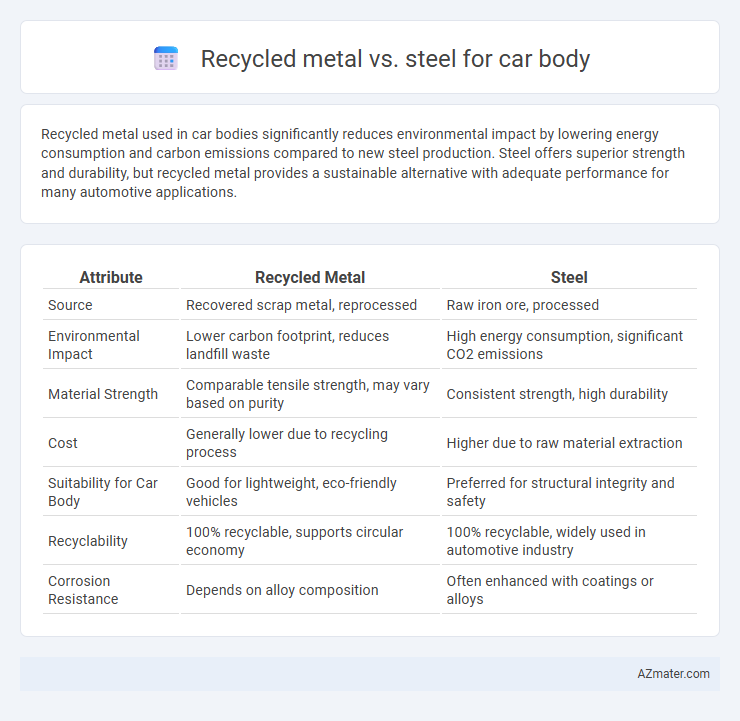Recycled metal used in car bodies significantly reduces environmental impact by lowering energy consumption and carbon emissions compared to new steel production. Steel offers superior strength and durability, but recycled metal provides a sustainable alternative with adequate performance for many automotive applications.
Table of Comparison
| Attribute | Recycled Metal | Steel |
|---|---|---|
| Source | Recovered scrap metal, reprocessed | Raw iron ore, processed |
| Environmental Impact | Lower carbon footprint, reduces landfill waste | High energy consumption, significant CO2 emissions |
| Material Strength | Comparable tensile strength, may vary based on purity | Consistent strength, high durability |
| Cost | Generally lower due to recycling process | Higher due to raw material extraction |
| Suitability for Car Body | Good for lightweight, eco-friendly vehicles | Preferred for structural integrity and safety |
| Recyclability | 100% recyclable, supports circular economy | 100% recyclable, widely used in automotive industry |
| Corrosion Resistance | Depends on alloy composition | Often enhanced with coatings or alloys |
Introduction to Car Body Materials
Car bodies predominantly utilize steel due to its strength, durability, and cost-effectiveness, with recycled metal increasingly incorporated to enhance sustainability. Recycled steel retains high structural integrity while reducing environmental impact by lowering energy consumption and raw material use in manufacturing. Automotive industries prioritize recycled metal to meet regulatory standards for emissions and promote circular economy practices in vehicle production.
Overview of Recycled Metal in Automotive Manufacturing
Recycled metal in automotive manufacturing significantly reduces environmental impact by conserving natural resources and lowering energy consumption compared to producing new steel. The use of recycled aluminum and steel alloys for car bodies enhances sustainability while maintaining structural integrity and durability required for safety standards. Emphasizing circular economy principles, recycled metal contributes to cost efficiency and supports automotive industry goals for reduced carbon emissions.
What is Steel? Properties and Uses in Car Bodies
Steel is an alloy composed primarily of iron and carbon, known for its high strength, durability, and malleability, making it ideal for car body construction. Its excellent impact resistance and ability to absorb energy contribute to vehicle safety, while corrosion-resistant variants like galvanized steel enhance longevity. Widely used in automotive manufacturing, steel enables complex designs and structural integrity, supporting both traditional and modern car body applications.
Environmental Impact: Recycled Metal vs Steel
Recycled metal significantly reduces environmental impact by lowering energy consumption and greenhouse gas emissions compared to producing new steel from raw ore. Using recycled metal in car bodies decreases mining waste and conserves natural resources, contributing to a more sustainable automotive industry. Steel manufacturing from virgin materials typically generates higher carbon footprints due to intensive extraction and processing activities.
Strength and Durability Comparison
Recycled metal used in car bodies maintains comparable strength to new steel while offering enhanced environmental benefits through reduced resource consumption. Steel, known for its high tensile strength and durability, provides exceptional impact resistance and longevity critical for vehicle safety. Advances in recycling technology ensure that recycled steel retains essential structural integrity, making it a sustainable yet reliable choice for automotive manufacturing.
Cost Analysis: Recycled Metal vs Traditional Steel
Recycled metal for car bodies significantly reduces material costs by up to 40% compared to traditional steel due to lower energy consumption in processing and decreased reliance on raw ore extraction. Steel sourced from virgin materials involves higher expenses related to mining, refining, and energy-intensive production methods, making recycled metal a financially advantageous choice in automotive manufacturing. Cost efficiency is further enhanced by the reduced carbon footprint of recycled metal, aligning with industry trends toward sustainable and budget-conscious vehicle production.
Manufacturing Processes and Industrial Compatibility
Recycled metal for car bodies significantly reduces energy consumption by up to 75% compared to producing steel from raw ore, streamlining the manufacturing process through less intensive melting and refining steps. Steel, particularly automotive-grade steel, offers consistent mechanical properties and weldability, ensuring industrial compatibility with existing stamping, welding, and assembly line equipment. Utilizing recycled metal necessitates thorough sorting and alloy reconstitution to match the precise specifications required in automotive manufacturing, making it a sustainable yet technically demanding alternative to traditional steel production.
Performance and Safety Considerations
Recycled metal used in car bodies offers comparable strength and durability to new steel, often meeting the same industry standards for impact resistance and crashworthiness. Steel, particularly high-strength steel grades, provides excellent structural integrity and energy absorption during collisions, making it a staple in automotive safety design. Performance and safety considerations demand rigorous testing of recycled metal to ensure it retains key mechanical properties, such as tensile strength and ductility, essential for protecting occupants in accidents.
Market Trends and Consumer Perspectives
The market for recycled metal in car bodies is expanding due to increased demand for sustainable manufacturing and lower carbon footprints compared to traditional steel. Consumers are showing a growing preference for vehicles with recycled materials, driven by environmental awareness and potential cost benefits. Steel remains dominant for its durability and safety, but automakers are integrating recycled metal to meet regulatory pressures and evolving consumer expectations.
Future Outlook: Sustainable Materials for Car Bodies
Recycled metal offers significant environmental benefits by reducing carbon emissions and resource depletion, making it a key contender for sustainable car body manufacturing. Steel remains dominant due to its strength, recyclability, and evolving technologies that integrate recycled content without compromising vehicle safety. Advances in alloy design and processing techniques point toward increased use of recycled steel, positioning it as a cornerstone in the automotive industry's shift toward greener, more sustainable materials.

Infographic: Recycled metal vs Steel for Car body
 azmater.com
azmater.com